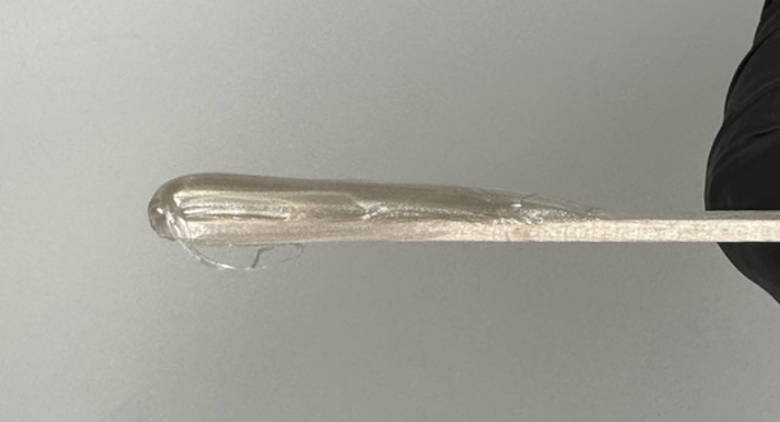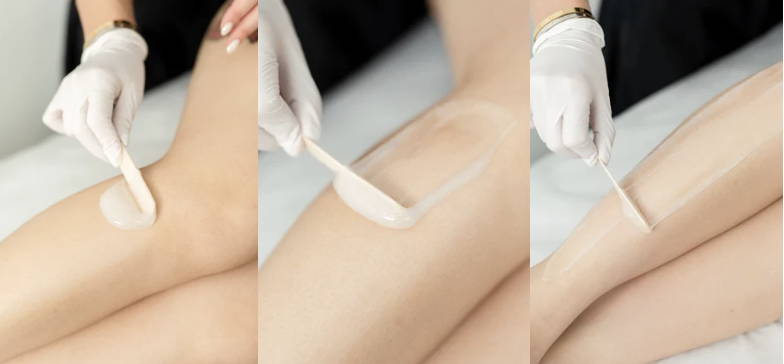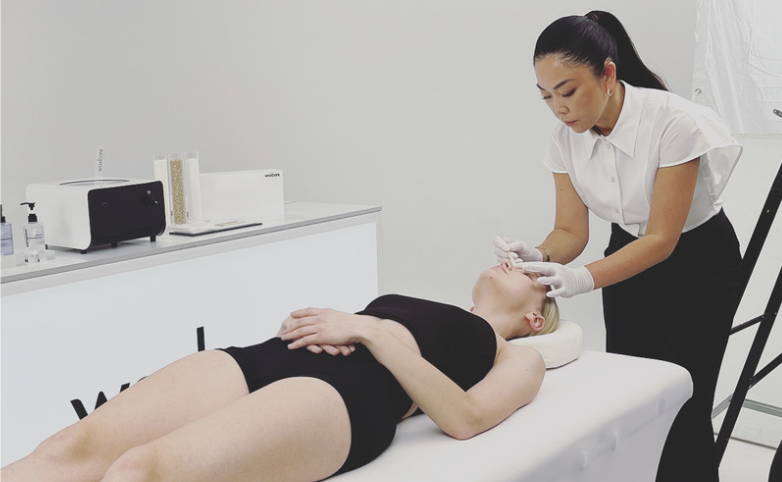
Welcome to our comprehensive guide on mastering waxing techniques!
Achieving efficient and thorough hair removal with minimal skin irritation is an art that involves employing precise and accurate techniques to ensure no product or time is wasted.
We’ve narrowed down the FIVE most important factors that contribute to a successful wax procedure:
2. Understanding the impact of temperature on wax behavior
3. Effective Prep and Use of Wax products
4. Employing Mapping Patterns with Every Service
Whether you're a professional in the beauty industry or an aspiring student eager to refine your skills, this blog will guide you through the process of waxing with ease, efficiency and effectiveness.
1. Application Techniques
Let's start with the basics. At Waxbare, we firmly believe that achieving a successful wax application begins at the wax pot. We emphasize the importance of working clean, both obtaining and maintaining control over the wax throughout the entire process.
We employ two techniques to obtain the proper amount of wax on the stick: The first method we refer to as The “Scoop, Dip, and Twist” method, and the second is the “Tap and Edge Clean-Up” method. To maintain a neat and efficient workspace, it is crucial to ensure that the wax stick is free from any strings before moving from the wax warmer to the skin.
Obtaining the Correct Amount of Wax on Stick for Desired Area:
Before acquiring wax, it is crucial to assess the size of the waxing area to determine the appropriate stick size and how much wax to use.
For precise work or small areas like the lips or eyebrows, utilize SMALL sticks and obtain the wax utilizing our “tap and edge cleanup” method. When using a small stick, keep wax to the top 1/4 of the stick, ensuring the wax remains on one side. This will enhance precision and facilitate a smooth application.
When dealing with medium size areas, such as the bikini line or underarms, obtain a MEDIUM BULB on a large stick. To achieve a medium bulb, limit the wax to the top 1/6 of the stick.
For wider or longer strips, like those for the legs, back, or chest, opt for a LARGE BULB on a large stick. When obtaining a large bulb, confine the wax to the Top 1/3-1/4 of the stick.
To consistently maintain control of the wax bulb, keep the wax stick horizontal while rotating the bulb of wax and follow through with a horizontal hold until the wax is fully dispensed onto the skin.
Wax Control and Stick Placement:
We begin wax control at the wax pot by utilizing the Scoop, Dip, and Twist or the Tap and Edge Clean-Up method. We maintain control throughout the application by using the “90/45 Rule” for horizontal stick application and adjust the stick hold vertically for a vertical stick application.
Horizontal Stick Application for larger and longer strips:
The” 90/45 Rule” involves dragging wax using the long edge of the stick keeping at 90 degrees to the skin. Slightly position stick where the tip aims downward at approximately 45 degrees to the skin.
Vertical Stick Application for narrow strips and more precise control:
When holding the stick vertically, position your hand closer to the wax bulb which will allow you to apply more pressure and have greater control.
Forming the strip:
First dispense wax on to the skin to prepare for spreading. When distributing wax from top to bottom and side to side, follow the direction indicated by the direction the tip of the stick is pointing. Consciously keep the stick from tilting forward or backward. This will ensure an even distribution of the wax, well-defined edges on both sides of the strip and will leave sufficient wax in place to create a prominent pull tab.
Removal of the strip:
Flexible hard waxes may be gently removed in a slower but fluid motion. Rather than trying to remove the strip in one swift and quick pull, another option is to employ the “segmented removal method.” This will allow for the re-bracing of the hand to hold the skin taut as the trip is removed and will minimize hair breakage.
2. The Impact of Temperature has on Technique and Waxing Results:
There are a multitude of factors to consider when discussing how temperature impacts technique as well as the results of a waxing service.
Wax temperature:
The temperature of your wax plays a crucial role in wax performance and client comfort. Failing to maintain the right temperature can lead to issues such as overuse of product, reduced hair-grabbing capability, and the potential for burns or unnecessary skin irritation when wax is too hot. Conversely, when the wax is too cool, it can result in thicker strips, product overuse, and difficulties in forming long or large strips, ultimately extending the service time and reducing profit.
Both excessively high and low temperatures can affect the waxing process. For optimal effectiveness and efficiency, Waxbare waxes perform best when heated to the range of 130-135 degrees.
To ensure the right temperature, you can use a laser thermometer. Additionally, you can gauge consistency by holding a substantial bulb of wax horizontally over the wax pot. Ideally, it should take around 5-6 seconds for the bulb to drop. If it drops faster than 5 seconds, your wax is too hot. On the other hand, if it takes longer, the wax is too cool.
Body temperature plays a crucial role in waxing performance. Slightly warm skin increases blood flow and relaxes clients. Overly cold skin can create goosebumps and cause the client to tense up, affecting the ability of the wax to adequately remove the hair.
Also keep in mind that repeatedly waxing in the same area can raise the client's body temperature and impact wax behavior. To reduce the risk of skin overheating and minimize skin irritation, it's advisable to use low-temperature wax, proper pressure, and efficient mapping patterns to shorten both service time and amount of application strips, resulting in better hair removal outcomes and minimal skin irritation.

Room temperature:
Maintaining a room temperature between 70°F to 75°F is generally comfortable for both the waxing professional and the client during a waxing session. Room temperature can influence wax consistency as well as body temperature, with cold rooms causing the wax to thicken and become less effective, while warm rooms can make the wax too thin. Proper room temperature is crucial for optimal hair removal, preventing discomfort and ensuring the client’s comfort.
3.Correct Use of Pre and Post Care Products
Tending to the skin with the right products before and after the service will not only prevent severe skin reactions, and reduce the chance of post wax breakouts, it will allow your wax to work most effectively.
Cleanser: can be used to thoroughly prep skin and hair for optimal removal. Not cleansing the skin prior to waxing can increase the risk of breakouts and contribute to poor wax adherence. Cleansing prior to waxing not only removes makeup, oil and unwanted bacteria, the cleansing motions help loosen any hair that may be slightly ingrown. This step also allows the service provider to evaluate the client’s skin condition and hair growth pattern for a more efficient application.
Oil: a few drops of oil can be used to create a protective skin barrier and to balance skin conditions that are more likely to be reactive to a waxing procedure. Clients with dry, sensitive or unbalanced skin are likely to have more severe skin reactions and are at increased risk of skin lifting and low pain tolerance. Addressing dryness, sensitivity or an unbalanced skin barrier prior to the wax application will decrease the potential and severity of waxing complications.
Powder: can help reduce excessive moisture. If too much oil or moisture is present on the skin’s surface, the wax may have a challenging time spreading and adhering to the hair.
For oily skin types or for warmer skin areas that produce perspiration, apply a small amount of powder to the area prior to waxing to help absorb excess moisture.
Use powder in moderation. The presence of too much powder may also absorb moisture in the wax which will reduce its flexibility, causing some waxes to get brittle and break.
Post Wax Toners, Serums or Lotions
After a waxing session, it's beneficial to apply products such as toners, serums, or lotions to soothe and protect the freshly waxed skin. Failing to restore balance to the skin after hair removal can intensify adverse reactions like redness, bumps, hives, and itchiness.
4. Use Mapping Patterns:
A mapping pattern is a systematic and organized approach a waxing professional uses to apply wax and remove hair in a specific area. It involves dividing the targeted area into smaller sections or zones and following a strategic pattern to ensure thorough and efficient hair removal.
Mapping patterns, also known as waxing patterns, are instrumental in optimizing time efficiency and minimizing the consumption of supplies, ultimately leading to an expanded profit margin. Furthermore, these patterns guarantee comprehensive coverage of all areas and mitigate the risk of excessive passes, safeguarding the skin from potential overwork and irritation.
Utilizing a mapping pattern for each service area removes the guesswork and frustration from the process. This allows waxers to keep a clear mind, enabling concentration on perfecting the application technique while being fully engaged with the client.

5. Ensure Client Comfort:
To ensure a comfortable waxing experience for clients, it is best to employ a mindful treatment approach. Effective communication before the session sets expectations, while creating a relaxing environment during the service contributes to a positive atmosphere.
As mentioned above, maintaining optimal room and wax temperatures is crucial for client comfort, along with the use of high-quality products tailored to individual skin needs.
Proper body positioning, checking for sensitivity, and offering pain-reducing techniques such as, hand pressure following removal of a strip, can also further enhance the experience. Distraction techniques, such as engaging conversation or soothing music, help divert attention from discomfort.

Conclusion:
Mastering proper waxing techniques, precise temperature control, proper use of products. strategic mapping patterns, and a keen focus on client comfort collectively form the foundation of a successful waxing procedure.
Diligently perfecting these fundamental skills not only enhances one's expertise and confidence but also contributes to a positive and comfortable experience for clients, ultimately establishing a reputation for excellence in the art of waxing.
Having mastered the basics of waxing techniques, it's time to explore specialized areas and refine your skills. Check out our diverse range of blogs for in-depth insights and tips:
For more Blogs click here










